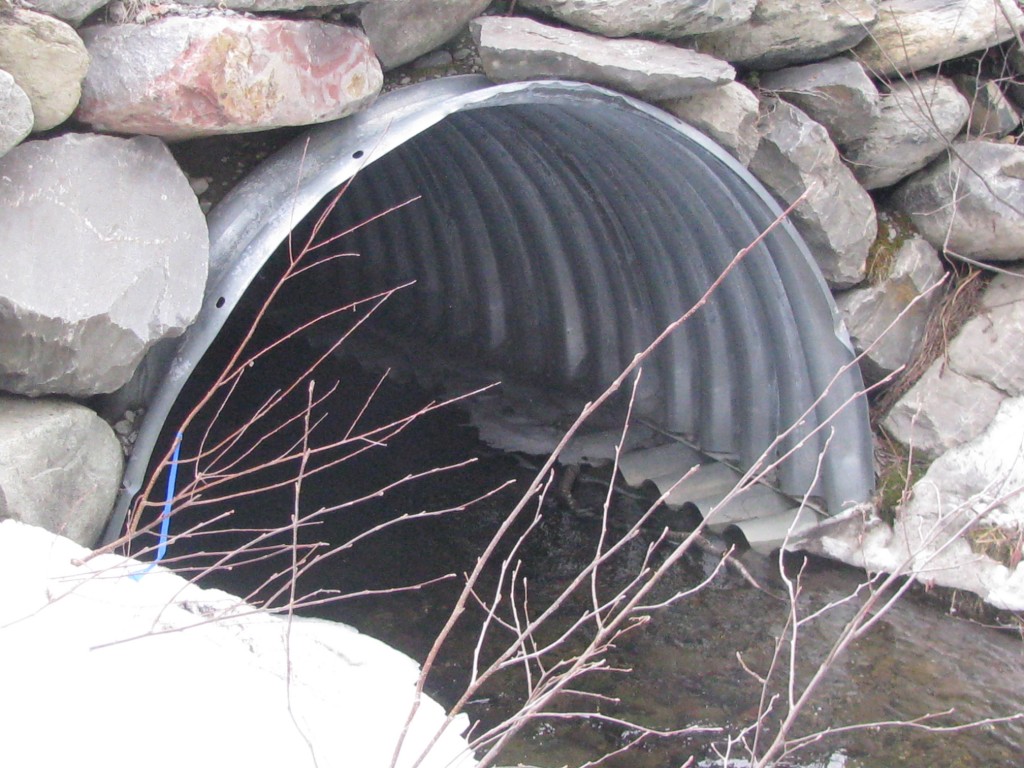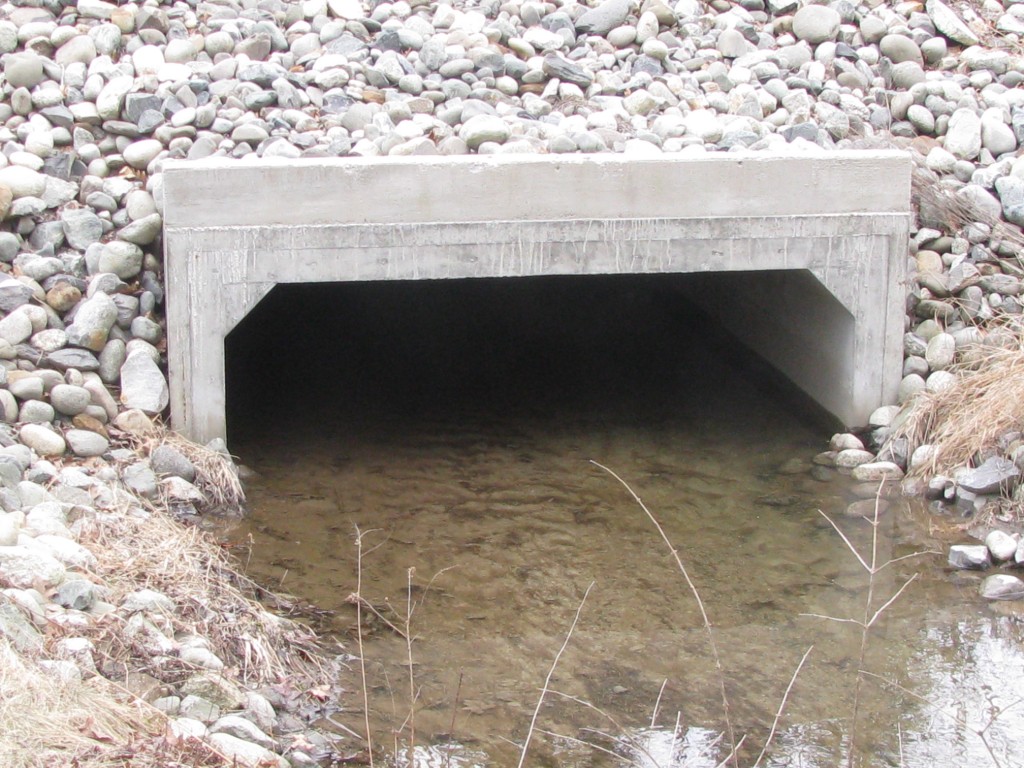April 13, 2016 at 4:58 pm
[caption id="attachment_1398" align="alignright" width="514"] A half culvert like this one, place on cement footings, allows for a natural stream bottom that allows for the passage of fish and other species.[/caption]
By Joe Wiley, IFW Wildlife Biologist
Landowners, both large and small often need to create access or upgrade existing access to their lands. In order to limit impacts to habitat, landowners should try to avoid crossing streams if it is possible. If a crossing over a stream is unavoidable, it makes sense to limit crossings to only areas where they are essential.
Stream crossings will use a variety of different structures such as metal or plastic culverts, box culverts or bridges. However, not all of these are created equally. Of course, these structures need to be sized appropriately to safely meet the anticipated flows expected in the river or stream, and minimize both “velocity”, “low flow” and other common barriers to fish passage. These are purposely designed oversized, so that they can handle an unusually large flood event such as 25 or 50 year storm. Of course, they also need to be cost efficient for the property owner.
[caption id="attachment_1399" align="alignleft" width="558"]
A half culvert like this one, place on cement footings, allows for a natural stream bottom that allows for the passage of fish and other species.[/caption]
By Joe Wiley, IFW Wildlife Biologist
Landowners, both large and small often need to create access or upgrade existing access to their lands. In order to limit impacts to habitat, landowners should try to avoid crossing streams if it is possible. If a crossing over a stream is unavoidable, it makes sense to limit crossings to only areas where they are essential.
Stream crossings will use a variety of different structures such as metal or plastic culverts, box culverts or bridges. However, not all of these are created equally. Of course, these structures need to be sized appropriately to safely meet the anticipated flows expected in the river or stream, and minimize both “velocity”, “low flow” and other common barriers to fish passage. These are purposely designed oversized, so that they can handle an unusually large flood event such as 25 or 50 year storm. Of course, they also need to be cost efficient for the property owner.
[caption id="attachment_1399" align="alignleft" width="558"] This pre-cast concrete structure is relatively easy to install and is cost-efficient with an expected lifespan of 80 years.[/caption]
The best crossing structures retain the natural stream bed, allowing the stream to function normally. This not only provides fish passage but allows for all the other biological components of the stream ecosystem such as amphibians, reptiles, invertebrates and mammal passage within the watershed. Another important benefit of crossing structures that maintain the natural stream width is a significant reduction in beaver problems.
Culverts are the least desirable for crossings of perennial streams because of their relatively short life span and the constrictions culverts impose to the natural stream width. Plastic culverts have the same drawbacks and their smooth inner surface increases water velocity significantly. Alternatively, modular concrete arches, box bridges and bridge deck panels along with concrete footings and abutment blocks are manufactured in several sizes suitable for most any situation. Based on a service life of +/- 80 years concrete stream crossing structures are the most cost effective, are fish and wildlife friendly and are easy to install. A North Anson Maine company is currently manufacturing pre-cast concrete crossing structures that maintain the natural stream bed of the stream .
This pre-cast concrete structure is relatively easy to install and is cost-efficient with an expected lifespan of 80 years.[/caption]
The best crossing structures retain the natural stream bed, allowing the stream to function normally. This not only provides fish passage but allows for all the other biological components of the stream ecosystem such as amphibians, reptiles, invertebrates and mammal passage within the watershed. Another important benefit of crossing structures that maintain the natural stream width is a significant reduction in beaver problems.
Culverts are the least desirable for crossings of perennial streams because of their relatively short life span and the constrictions culverts impose to the natural stream width. Plastic culverts have the same drawbacks and their smooth inner surface increases water velocity significantly. Alternatively, modular concrete arches, box bridges and bridge deck panels along with concrete footings and abutment blocks are manufactured in several sizes suitable for most any situation. Based on a service life of +/- 80 years concrete stream crossing structures are the most cost effective, are fish and wildlife friendly and are easy to install. A North Anson Maine company is currently manufacturing pre-cast concrete crossing structures that maintain the natural stream bed of the stream .
 A half culvert like this one, place on cement footings, allows for a natural stream bottom that allows for the passage of fish and other species.[/caption]
By Joe Wiley, IFW Wildlife Biologist
Landowners, both large and small often need to create access or upgrade existing access to their lands. In order to limit impacts to habitat, landowners should try to avoid crossing streams if it is possible. If a crossing over a stream is unavoidable, it makes sense to limit crossings to only areas where they are essential.
Stream crossings will use a variety of different structures such as metal or plastic culverts, box culverts or bridges. However, not all of these are created equally. Of course, these structures need to be sized appropriately to safely meet the anticipated flows expected in the river or stream, and minimize both “velocity”, “low flow” and other common barriers to fish passage. These are purposely designed oversized, so that they can handle an unusually large flood event such as 25 or 50 year storm. Of course, they also need to be cost efficient for the property owner.
[caption id="attachment_1399" align="alignleft" width="558"]
A half culvert like this one, place on cement footings, allows for a natural stream bottom that allows for the passage of fish and other species.[/caption]
By Joe Wiley, IFW Wildlife Biologist
Landowners, both large and small often need to create access or upgrade existing access to their lands. In order to limit impacts to habitat, landowners should try to avoid crossing streams if it is possible. If a crossing over a stream is unavoidable, it makes sense to limit crossings to only areas where they are essential.
Stream crossings will use a variety of different structures such as metal or plastic culverts, box culverts or bridges. However, not all of these are created equally. Of course, these structures need to be sized appropriately to safely meet the anticipated flows expected in the river or stream, and minimize both “velocity”, “low flow” and other common barriers to fish passage. These are purposely designed oversized, so that they can handle an unusually large flood event such as 25 or 50 year storm. Of course, they also need to be cost efficient for the property owner.
[caption id="attachment_1399" align="alignleft" width="558"] This pre-cast concrete structure is relatively easy to install and is cost-efficient with an expected lifespan of 80 years.[/caption]
The best crossing structures retain the natural stream bed, allowing the stream to function normally. This not only provides fish passage but allows for all the other biological components of the stream ecosystem such as amphibians, reptiles, invertebrates and mammal passage within the watershed. Another important benefit of crossing structures that maintain the natural stream width is a significant reduction in beaver problems.
Culverts are the least desirable for crossings of perennial streams because of their relatively short life span and the constrictions culverts impose to the natural stream width. Plastic culverts have the same drawbacks and their smooth inner surface increases water velocity significantly. Alternatively, modular concrete arches, box bridges and bridge deck panels along with concrete footings and abutment blocks are manufactured in several sizes suitable for most any situation. Based on a service life of +/- 80 years concrete stream crossing structures are the most cost effective, are fish and wildlife friendly and are easy to install. A North Anson Maine company is currently manufacturing pre-cast concrete crossing structures that maintain the natural stream bed of the stream .
This pre-cast concrete structure is relatively easy to install and is cost-efficient with an expected lifespan of 80 years.[/caption]
The best crossing structures retain the natural stream bed, allowing the stream to function normally. This not only provides fish passage but allows for all the other biological components of the stream ecosystem such as amphibians, reptiles, invertebrates and mammal passage within the watershed. Another important benefit of crossing structures that maintain the natural stream width is a significant reduction in beaver problems.
Culverts are the least desirable for crossings of perennial streams because of their relatively short life span and the constrictions culverts impose to the natural stream width. Plastic culverts have the same drawbacks and their smooth inner surface increases water velocity significantly. Alternatively, modular concrete arches, box bridges and bridge deck panels along with concrete footings and abutment blocks are manufactured in several sizes suitable for most any situation. Based on a service life of +/- 80 years concrete stream crossing structures are the most cost effective, are fish and wildlife friendly and are easy to install. A North Anson Maine company is currently manufacturing pre-cast concrete crossing structures that maintain the natural stream bed of the stream .